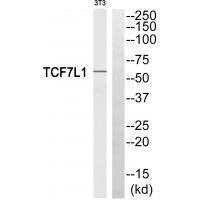
| WB | 咨询技术 | Human,Mouse,Rat |
| IF | 咨询技术 | Human,Mouse,Rat |
| IHC | 咨询技术 | Human,Mouse,Rat |
| ICC | 技术咨询 | Human,Mouse,Rat |
| FCM | 咨询技术 | Human,Mouse,Rat |
| Elisa | 咨询技术 | Human,Mouse,Rat |
| Aliases | Transcription factor 7-like 1; HMG box transcription factor 3; TCF-3; TCF7L1; TCF3 |
| Entrez GeneID | 83439; |
| WB Predicted band size | 63kDa |
| Host/Isotype | Rabbit IgG |
| Antibody Type | Primary antibody |
| Storage | Store at 4°C short term. Aliquot and store at -20°C long term. Avoid freeze/thaw cycles. |
| Species Reactivity | Human,Mouse |
| Immunogen | Synthesized peptide derived from internal of human TCF7L1. |
| Formulation | Purified antibody in PBS with 0.05% sodium azide. |
+ +
以下是关于TCF7L1抗体的3篇代表性文献,包含文献名称、作者及摘要内容概括:
---
1. **文献名称**: *TCF7L1 regulates embryonic stem cell pluripotency and self-renewal by transcriptional repression of Wnt/β-catenin signaling*
**作者**: Hsu, S. C., et al.
**摘要**: 该研究利用TCF7L1抗体进行ChIP-seq和免疫沉淀实验,揭示了TCF7L1通过抑制Wnt/β-catenin信号通路维持胚胎干细胞多能性,并发现其与Oct4/Sox2等核心多能性因子存在相互作用。
---
2. **文献名称**: *TCF7L1 functions as a tumor suppressor in colorectal cancer via antagonizing the Wnt/β-catenin pathway*
**作者**: Zhang, Y., et al.
**摘要**: 通过免疫组化(使用TCF7L1抗体)和基因敲除模型,研究发现TCF7L1在结直肠癌中低表达,其缺失导致β-catenin信号异常激活,促进肿瘤侵袭和转移,提示其作为抑癌基因的作用机制。
---
3. **文献名称**: *Differential roles of TCF7L1 and TCF7L2 in mammary gland development and oncogenesis*
**作者**: King, M. L., et al.
**摘要**: 研究使用TCF7L1特异性抗体分析小鼠乳腺组织,发现TCF7L1通过抑制上皮-间质转化(EMT)维持乳腺导管稳态,而TCF7L2则促进增殖,二者在乳腺癌发生中呈现相反功能。
---
4. **文献名称**: *TCF7L1 modulates chromatin accessibility to regulate target gene expression during neuroectodermal differentiation*
**作者**: Liu, J., et al.
**摘要**: 通过TCF7L1抗体的染色质构象捕获(3C)和Western blot实验,证明TCF7L1在神经外胚层分化中通过重塑染色质结构抑制多能性基因(如Nanog),同时激活神经特异性基因表达。
---
这些文献涵盖了TCF7L1在干细胞调控、癌症机制及发育生物学中的关键作用,均涉及抗体的实验验证(如Western blot、免疫组化或ChIP-seq)。如需具体DOI或期刊信息,可进一步补充数据库检索关键词。
The TCF7L1 antibody is a crucial tool for studying the role of TCF7L1 (T-cell factor 7-like 1), a transcription factor within the Wnt/β-catenin signaling pathway. TCF7L1. a member of the TCF/LEF family, binds to DNA through its high-mobility group (HMG) domain and regulates gene expression by interacting with β-catenin. Unlike other TCF family members, TCF7L1 primarily acts as a transcriptional repressor, suppressing Wnt target genes in the absence of Wnt signaling. It plays vital roles in embryonic development, stem cell maintenance, and epithelial cell differentiation. Dysregulation of TCF7L1 is implicated in cancers (e.g., colorectal, breast), metabolic disorders (e.g., diabetes), and fibrotic diseases.
Antibodies targeting TCF7L1 are widely used in research to detect protein expression, localization, and interactions via techniques like Western blotting, immunohistochemistry (IHC), immunofluorescence (IF), and chromatin immunoprecipitation (ChIP). These antibodies often recognize specific isoforms or domains (e.g., N-terminal or C-terminal regions) to ensure experimental specificity. Commercially available TCF7L1 antibodies are typically monoclonal or polyclonal, validated for cross-reactivity and batch consistency. Researchers rely on them to explore TCF7L1’s dual role in Wnt signaling—repressing targets in unstimulated conditions and switching to activation upon β-catenin binding. Proper validation using knockout controls or siRNA-mediated knockdown is critical due to homology among TCF family members. Overall, TCF7L1 antibodies are indispensable for unraveling its context-dependent functions in development and disease.
×